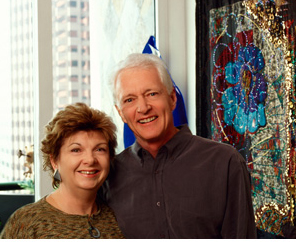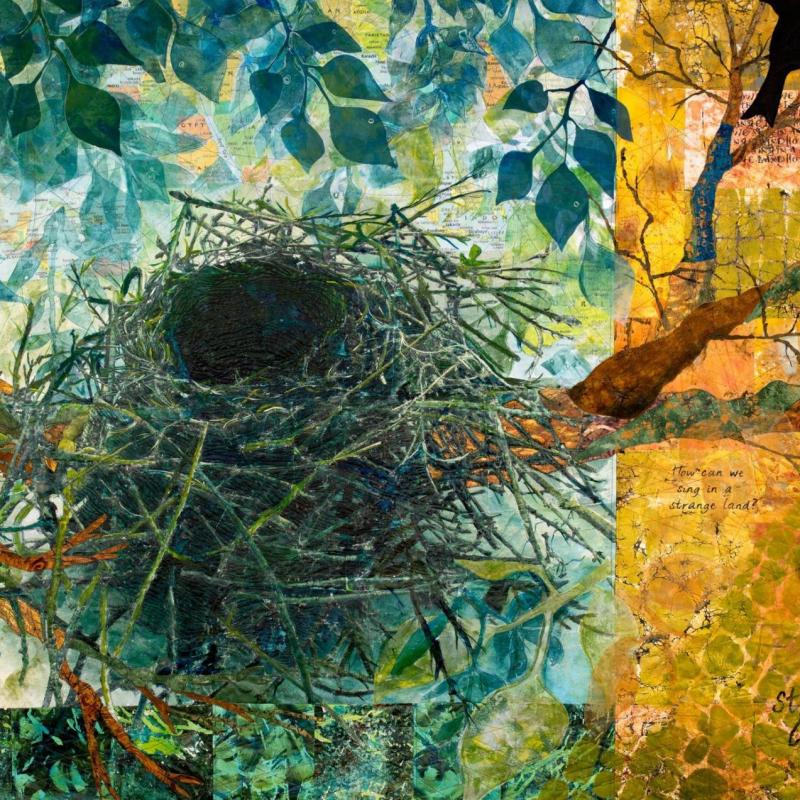Reprinted from the SAQA Journal, Vol. 11, No. 4, Fall 2001

For the past thirteen years we have been collecting contemporary art quilts. Our collection includes 120 pieces with two core focuses. The first group are quilts by Pacific Northwest artists. The second, the "Full Deck Art Quilts" collection.
During our travels to shows and exhibitions, we are often asked questions about our collection. The questions tend to fall into the "who, what, when, where, why, and how" categories. Below are some questions we are frequently asked along with our answers. Remember, we are just two collectors and may not represent the thoughts of all collectors. Even the two of us may have different answers!
How did you get started?
Thirteen years ago we were in Washington and saw an advertisement for American Art Company in Tacoma. At that time we had a collection of Harold Altman lithographs and the ad indicated that the gallery dealt in Altmans. After contacting Rick Gottas at the gallery, we received his notice for an invitational contemporary art quilt exhibition at the gallery. We had never seen a contemporary art quilt. We were blown away by the quilt on the front of the card, Erika Carter's "Intertidal Wilderness," and decided we had to see more. Nancy flew up for the show, purchased Erika's piece and two others. And the rest is history.
What do you look for when contemplating an addition to your collection?
We don't look "for" anything; it's what speaks to us. And what speaks to us is fluid. In the early years, we focused on color, design, and technique. As we became more knowledgeable, different characteristics began to speak to us, such as, creativity and innovation in technique, fearlessness of the artist. We are drawn to narrative pieces. No matter how much a piece speaks to us, we do have a budget to consider. Size is also a consideration. Given our limited exhibition and storage space, smaller is better for us right now.
When did you become collectors?
That is a very interesting question. At the beginning, we were purchasers as opposed to collectors. At some point, perhaps when there was some critical mass to the pieces we owned and we had a deeper understanding of, and passion for, the medium, we became collectors. And that distinction changes things. As collectors we feel responsible for protecting the condition of our pieces, for protecting the artists' rights, and for promoting the medium and artists. It is impossible to say exactly when that change from purchaser to collector occurred.
Why is your collection predominantly by artists from the Pacific Northwest?
There are several reasons. Our first exposure to the medium was the exhibition at American Art Company that included only Pacific Northwest artists. Rick Gottas did his job by educating us, keeping us informed, introducing us to artists, and making it easy for us to see top-notch work. Also, we decided that if we were to continue purchasing contemporary art quilts we needed a focus. There are many talented artists all over the United States but that seemed too broad. We decided the focus should be artists from the Pacific Northwest as the work was very interesting and provocative. This geographic focus would also allow us to meet many artists in our collection which is important to us. Finally, the purchase of the "Full Deck" collection allowed us to add works by many of the finest artists in the country outside of the Pacific Northwest.
Who are you looking to add to your collection?
We don't make our purchases based on "who" or trying to fill out our collection. Every piece we have purchased has spoken to us in some way regardless of the artist. That remains our criteria.
How can artists improve their chances of having their work seen and purchased by collectors?
Typically, a collector's first exposure to a piece is through a slide or photograph, not the actual piece itself. Therefore, it is imperative that a professional-quality slide be created for each piece. These days many pieces come to our attention through gallery owners whom we know and trust. Building a relationship with a gallery who understands and promotes the medium can be extremely helpful in many ways. Generally, unsolicited slides we receive from artists not known to us are rarely considered. If you do send slides to a collector, it is imperative that you include a postage-paid mailer for returning the slides unless you don't want them back. Belonging to a recognizable, high-quality organization such as SAQA, or CQA, enhances any artist's credibility.
As to the work itself, collectors like a good story about the piece. Not just about the technique, but the inspiration, background, message, importance to the artist, etc.
Follow-up after a purchase is very important. If not already provided, a complete curriculum vita is a must. Keep the collector apprised of upcoming shows, new work, awards, etc. Also, collectors generally love to show their collection and the artist can be the eyes and ears for possible opportunities. It is also a way to stay in touch with your collector. Keep in mind that collectors can change directions. The more solid your relationship with the collector, the more likely your work will continue to be of interest even after a change of direction.
What will eventually happen to your collection?
We have made plans for the collection to remain intact. As to its final destination, that remains to be seen. We would hope to place the collection with an appropriate museum. It will definitely not be sold at a yard sale.
Warren Brakensiek is a former member of the SAQA Board of Directors

